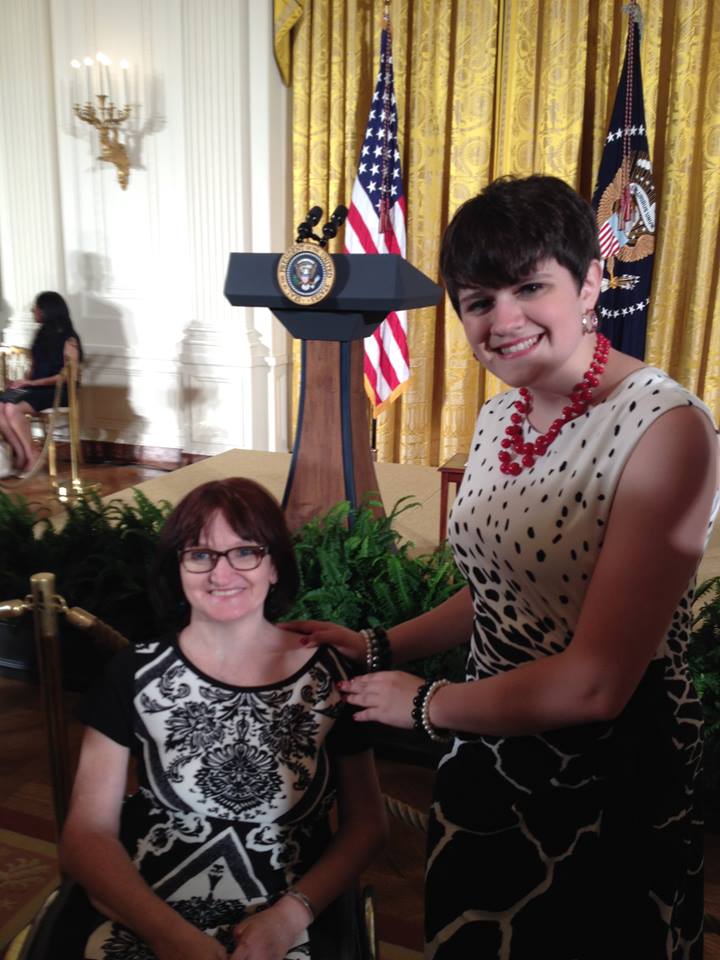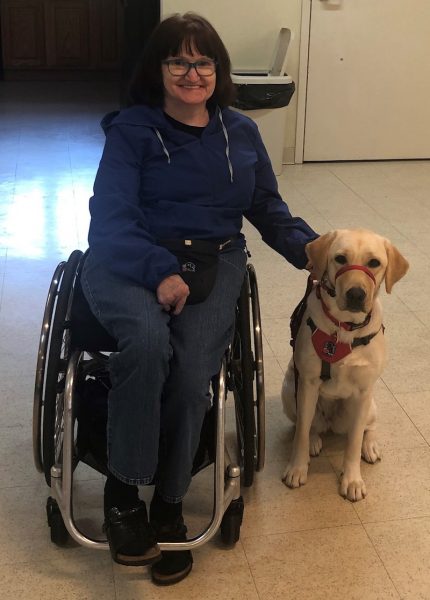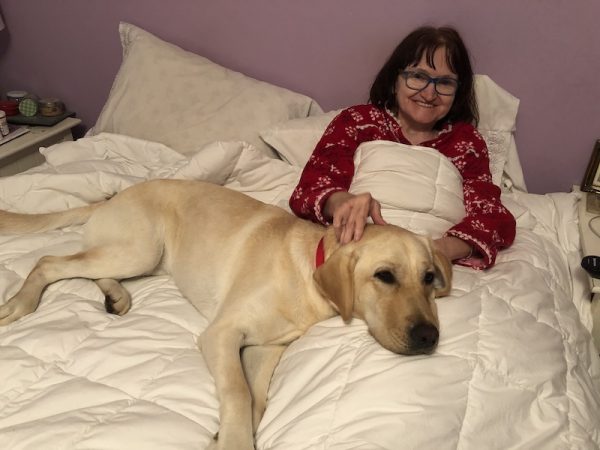
I first met Kathy McInnis-Misenor in the 80s when she was a member of an organization called the Maine Association of Handicapped Persons (MAHP) and often made the news because of the work she was doing to make buildings and transportation accessible. She was and still is, a fighter — for herself and for others. She learned at a young age.

When Kathy was five, she was diagnosed with juvenile rheumatoid arthritis, which causes persistent joint pain, swelling, and stiffness. At 10, she needed a cane or crutches to walk and by her early teens, was in a wheelchair.
Today, she gets around in a lightweight wheelchair. A nice one, she says, but at age 60 she needs more help with a lot of things most of us take for granted. As simple-seeming as opening a door or picking up something from the floor.
Our house is accessible, with things like kitchen cabinets at my height and a roll-in shower in the bathroom, but my elbows are gone and my fingers are gone and my back has gotten sore. Things that I would think nothing of, like bending over and picking up a pen on the floor or tugging open the refrigerator door or standing up to reach for something have become difficult tasks.
Kathy McInnis-Misenor
Kathy is not going through life alone. She has a strong support system that includes her husband Brett, daughter Sara and other family members (she’s one of 12 siblings) and friends, but she has always been fiercely independent. She has a Bachelor’s degree in social work and sociology and a Master’s degree in social work, community organization, public policy, planning, and financial administration.

She has devoted her life to helping other people, especially people with disabilities. In fact, she is a co-author of the Americans with Disabilities Act (ADA) and was invited to Washington, DC four years ago to help celebrate its 25th anniversary. She attended with her daughter.
For all Kathy continues to do for other people to make their lives a little easier, she needed a bit of a push from her sister Beth to get some extra help for herself. Beth thought she should get a service dog. Kathy was pretty skeptical at first.
I am a rather cynical person and I was, yeah, right, a dog is going to put his teeth on my toes and take my socks off. I don’t believe it.
Kathy
She finally agreed to look at some brochures and the organization that interested her the most was a non-profit organization named NEADS (it used to be known as National Education for Assistance Dog Services and Dogs for Deaf and Disabled Americans).
Kathy was familiar with NEADS because of her work with clients who were deaf and had a lot of faith in the company. So she applied, was accepted, and in October, went to the NEADS headquarters in Massachusetts for an intensive two-week training.
I tell you, I had to write a master’s thesis, I studied and graduated summa cum laude, and I have never been so nervous about going to school.
Kathy
The dog they had chosen for her was an English Yellow Lab named Sandy. Much to her amazement and delight, Kathy — that’s right, Kathy, not Sandy — passed the training. Sandy had been in training for more than a year and had already learned much of what Kathy needed.
The dog is already trained, but if you don’t do it correctly, the dog will look at you and tilt their head like, ‘I don’t understand you.’ They either didn’t understand your command or your command was odd. So it was really important for me to learn.
Kathy
After two weeks, Kathy and Sandy headed home to Maine and every day, Kathy continues to be amazed by what the dog can do.
She opens and closes doors by tugging on a rope tied to the handle and uses her nose to do things like push elevator buttons. When I say “paws,” she uses her paws to activate electric door openers. One of my favorite ones is I can tell her to fetch, fetch anything and she does. She can even fetch something I’ve printed on my printer.
Kathy
One of the most amazing things is how Sandy can pick things up, things as small as a quarter.
What they do is put their paw on it and get their tongue and top teeth on it and then they hold it between their teeth and bring it over and put it in your lap. Credit cards, they do the same way. They’ll hold it in their mouth horizontal and bring it over to you. Say “hold” and they’ll hold it there until you get your hands on it, then when you say “give”, they’ll open their mouth and give it to you.
Kathy
And one of the most interesting things Sandy learned was to not be afraid of clowns. That was important because Kathy’s husband is a Shriner’s clown and they wanted to be able to bring her to parades and not freak out when Brett was putting on his makeup and clown suit.
And the first time she saw my husband in clown makeup she recognized him — Oh hi, it’s you, but you’re looking different. It was wonderful.
Kathy
Another thing Sandy can do that will become even more helpful with time is to act as a brace when Kathy tries to transfer from one place to another, from her wheelchair to her bed, for instance. Because of arthritis, her joints have deteriorated. Over the past several years, her knees and hips have been replaced, but for now, her elbows are too tiny to be replaced and they are not in good shape.
We’re not sure if I’ll ever get replacements unless they perfect them for children, but I might have trouble transferring. I already do sometimes and it may get worse. I can tell Sandy to stand and stay and she will allow me to put my hand on her with my other hand on a grab bar and transfer from the shower, to the toilet, whatever. She won’t move, she won’t do anything.
Kathy
Sandy has already been a huge help to Kathy, but something else that is also important is do they like each other?
I love her and I’m so pleased because getting a service dog is an emotionally hard thing to do. It’s like when people move from a manual chair to a motorized one and think, ok, I’m losing some of my independence. But once you see the mind-blowing things they can do for a hug and a yes, good job, and a couple of pieces of kibble, you’re over it.
Just the other day I was paying a bill over the phone and dropped my credit card and I’d practiced it in Massachusetts, but the emotions came over me and I thought, oh, god, is she going to be able to do this because I’ve only done it in training. Before I said a word, she was standing over the card looking at me like do you want me to fetch this? And I said “fetch” and she picked it up.
Kathy
The cost of a service dog
So how much money do you think it takes to train a service dog like Sandy? It costs NEADS about $45,000 to acquire, raise, train, and match just one dog. Kathy didn’t have to pay a cent, but all of NEADS’ clients, including her, must commit to raising a minimum of $8000 to help support the organization.
How you can help Kathy
If you’d like to help Kathy raise her $8000, she has a fundraising page you can visit: Kathy McInnis-Misenor. So far, she has $2,346 in donations.
To learn more about NEADS, what kinds of dogs they train, how they train them, and for whom, visit their website. It’s full of information.





Leave A Comment